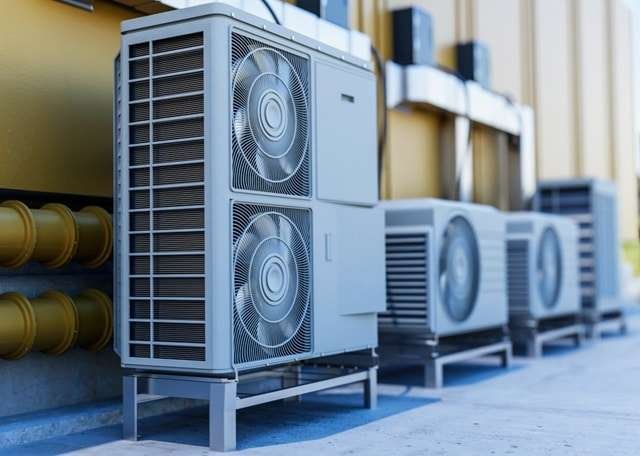In the realm of sustainable and efficient heating and cooling solutions, the geothermal heat pump stands out as a testament to innovation. These systems harness the Earth’s natural heat to provide warmth in winter and cooling in summer, all while significantly reducing energy consumption and carbon footprints.
Understanding the mechanics behind these technological marvels illuminates their efficacy and sheds light on their potential cost-saving benefits. So, let’s delve deep into the workings of geothermal heat pumps and explore how they operate while also considering the crucial aspect of geothermal heat pump cost.
Unearthing the Basics: What is a Geothermal Heat Pump?
Before diving into the intricate mechanisms of geothermal heat pumps, it’s essential to grasp their fundamental principles. Unlike traditional heating and cooling systems that rely on burning fossil fuels or electricity to generate heat or cool air, geothermal heat pumps leverage the constant temperature of the Earth’s subsurface to regulate indoor temperatures.
At depths below the Earth’s surface, typically around 20 feet or more, the temperature remains relatively stable throughout the year, unaffected by seasonal variations. Geothermal heat pumps capitalize on this consistency by transferring heat to or from the ground, depending on the desired indoor climate.
The Inner Workings: How Does It Operate?
Ground Heat Exchange:
- Heat Absorption (Heating Mode): In colder months, when indoor heating is required, a geothermal heat pump extracts heat from the ground through a series of underground pipes known as the ground loop. These pipes are filled with a heat-transferring fluid, typically water mixed with antifreeze, which absorbs heat from the soil.
- Heat Rejection (Cooling Mode): Conversely, during warmer seasons, when cooling is needed, the heat pump extracts heat from indoor air and transfers it to the fluid circulating in the ground loop. The heat is then absorbed by the relatively cooler ground, effectively cooling the indoor environment.
Heat Transfer:
- After absorbing or rejecting heat, the fluid travels through the ground loop and enters the heat pump unit installed inside the building.
- Within the heat pump, the fluid passes through a heat exchanger, transferring its thermal energy to a refrigerant circulating in a closed loop.
- As the refrigerant absorbs heat from the fluid, it vaporizes and is compressed by a compressor, significantly increasing its temperature.
Distribution:
- The hot or cold refrigerant then enters a coil system within the building’s ventilation system.
- In heating mode, the coil releases heat, which is distributed throughout the building via ductwork or radiant floor heating.
- Conversely, in cooling mode, the coil absorbs heat from indoor air, which is then expelled outside or transferred back into the ground loop for dissipation.
The Cost Factor: Understanding Geothermal Heat Pump Cost
While the operational efficiency and environmental benefits of geothermal heat pumps are widely acknowledged, the upfront installation cost can be a significant consideration for homeowners and businesses. Several factors influence the cost of a geothermal heat pump system, including:
System Size:
The heat pump size depends on various factors, including the size and layout of the building, climate conditions, and desired indoor comfort levels. Larger systems capable of heating or cooling larger spaces typically come with higher upfront costs.
Ground Loop Configuration:
The type and configuration of the ground loop, such as horizontal, vertical, or pond/lake loop, impact installation costs. Vertical loops, which require drilling boreholes deep into the ground, tend to be more expensive than horizontal loops, which are buried in trenches.
Installation Costs:
Labor costs for installation, including excavation, piping, and system setup, vary depending on factors such as local labor rates, soil conditions, and accessibility to the installation site.
Energy Efficiency Incentives:
Government incentives, tax credits, and rebates aimed at promoting renewable energy adoption can significantly offset the initial investment in a geothermal heat pump system, making it more financially viable in the long run.
Long-Term Savings: Calculating the Returns
While the initial investment in a geothermal heat pump system may seem daunting, it’s essential to consider the long-term savings and benefits it offers:
Energy Efficiency:
Geothermal heat pumps are highly energy-efficient, capable of delivering up to four units of heating or cooling for every unit of electricity consumed. This efficiency can substantially reduce energy bills over time, offsetting the initial installation costs.
Operational Savings:
With lower energy consumption and reduced reliance on fossil fuels, geothermal heat pump owners can enjoy significant savings on heating and cooling costs compared to conventional HVAC systems.
Durability and Longevity:
Geothermal heat pump systems are renowned for their durability and longevity, with properly maintained systems lasting upwards of 25 years or more.
This extended lifespan translates to lower lifecycle costs and greater overall savings.
Environmental Impact:
Geothermal heat pumps help reduce greenhouse gas emissions and mitigate environmental degradation associated with traditional heating and cooling methods by harnessing renewable energy from the Earth’s subsurface.
Conclusion:
In conclusion, the operational efficiency, environmental benefits, and long-term cost savings offered by geothermal heat pump systems make them a compelling choice for homeowners and businesses looking to reduce their carbon footprint and energy expenses. While the initial upfront cost may seem daunting, viewing it as an investment in sustainable comfort and future savings is crucial.
By harnessing the Earth’s natural heat, geothermal heat pumps provide a reliable and eco-friendly solution for heating and cooling needs, all while offering significant returns on investment over their lifespan. As technology advances and adoption rates increase, geothermal heat pumps are poised to play a pivotal role in the transition toward a more sustainable and energy-efficient future.







